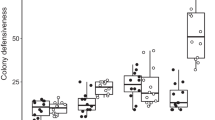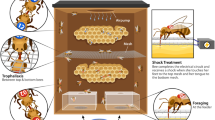Abstract
Information exchange of environmental cues facilitates decision-making processes among members of insect societies. In honeybee foraging, it is unknown how the odor cues of a resource are relayed to inactive nest mates to enable resource exploitation at specific scented sources. It is presumed that bees need to follow the dance or to be involved in trophallaxis with a successful forager to obtain the discovered floral scent. With this in mind, we evaluated the influence of food scent relayed through in-hive interactions and the subsequent food choices. Results obtained from five colonies demonstrated that bees arriving at a feeding area preferred to land at a feeder carrying the odor currently exploited by the trained forager. The bees that landed at this feeder also showed more in-hive encounters with the trained forager than the individuals that landed at the alternative scented feeder. The most frequent interactions before landing at the correct feeder were body contacts with the active forager, a behavior that involves neither dance following nor trophallaxis. In addition, a reasonable proportion of successful newcomers showed no conspicuous interactions with the active forager. Results suggest that different sources of information can be integrated inside the hive to establish an odor-rewarded association useful to direct honeybees to a feeding site. For example, simple contacts with foragers or food exchanges with non-active foragers seem to be enough to choose a feeding site that carries the same scent collected by the focal forager.





Similar content being viewed by others
References
Arenas A, Fernandez VM, Farina WM (2007) Floral odor learning within the hive affects honeybees' foraging decisions. Naturwissenschaften 94:218–222
Arenas A, Fernandez VM, Farina WM (2008) Floral scents experienced within the colony affect long-term foraging preferences in honeybees. Apidologie 39(6):714–722
Bates D (2007) lme4: Linear mixed-effects models using S4 classes. R package version 0.99875-7
Bolker BM, Brooks ME, Clark CJ, Geange SW, Poulsen JR, Stevens MHH, White JS (2009) Generalized linear mixed models: a practical guide for ecology and evolution. Trends Ecol Evol 24:127–135
de Vries H, Biesmeijer JC (1998) Modelling collective foraging by means of individual behaviour rules in honey bees. Behav Ecol Sociobiol 44:109–124
Díaz PC, Grüter C, Farina WM (2007) Floral scents affect the distribution of hive bees around dancers. Behav Ecol Sociobiol 61:1589–1597
Farina WM, Grüter C, Díaz PC (2005) Social learning of floral odours inside the honeybee hive. Proc R Soc Lond B 272:1923–1928
Farina WM, Grüter C, Acosta LE, Mc Cabe S (2007) Honeybees learn floral odors while receiving nectar from foragers within the hive. Naturwissenschaften 94:55–60
Fernández PC, Gil M, Farina WM (2003) Reward rate and forager activation in honeybees: recruiting mechanisms and temporal distribution of arrivals. Behav Ecol Sociobiol 54:80–87
Free JB (1969) Influence of the odour of a honeybee colony's food stores on the behaviour of its foragers. Nature 222:778
Gil M, De Marco RJ (2005) Olfactory learning by means of trophallaxis in Apis mellifera. J Exp Biol 208:671–680
Gil M, Farina WM (2002) Foraging reactivation in the honeybee Apis mellifera L.: factors affecting the return to a known nectar source. Naturwissenschaften 89:322–325
Grüter C, Farina WM (2009) The honeybee waggle dance: can we follow the steps? Trends Ecol Evol 24(5):242–247
Grüter C, Acosta LE, Farina WM (2006) Propagation of olfactory information within the honeybee hive. Behav Ecol Sociobiol 60:707–715
Johnson DL (1967) Communication among honey bees with field experience. Anim Behav 15:487–492
Johnson DL, Wenner AM (1966) A relationship between conditioning and communication in honeybees. Anim Behav 14:261–265
Menzel R, Kirbach A, Hass W-D, Fischer B, Fuchs J, Koblofsky M, Lehmann K, Reiter L, Meyer H, Nguyen H, Jones S, Norton P, Greggers U (2011) A common frame of reference for learned and communicated vectors in honeybee navigation. Curr Biol 21:645–650
Núñez JA (1982) Honeybee foraging strategies at a food source in relation to its distance from the hive and the rate of sugar flow. J Apic Res 21:139–150
Pflumm WW (1969) Stimmungsnderungen der Biene whrend des Aufenthalts an der Futterquelle. Z Vgl Physiol 65:299–323
Provecho Y, Josens R (2009) Olfactory memory established during trophallaxis affects food search behaviour in ants. J Exp Biol 212:3221–3227
R Development Core Team (2009) R: A language and environment for statistical computing. R Foundation for Statistical Computing, Vienna
Ramírez G, Martinez A, Fernández V, Corti Bielsa G, Farina WM (2010) The influence of honeybee gustatory responsiveness on in-hive social interactions. PLoS One 5(10):e13498. doi:10.1371/journal.pone.0013498
Reinhard J, Srinivasan MV, Guez D, Zhang SW (2004) Floral scents induce recall of navigational and visual memories in honeybees. J Exp Biol 207:4371–4381
Ribbands CR (1954) Communication between honeybees. I: the response of crop-attached bees to the scent of their crop. Proc R Entomol Soc Lond A 30:1–3
Riley JR, Greggers U, Smith AD, Reynolds DR, Menzel R (2005) The flight paths of honeybees recruited by the waggle dance. Nature 435:205–207
Seeley TD (1995) The wisdom of the hive: the social physiology of honey bee colonies. Harvard University Press, Cambridge
Tautz J (1996) Honeybee waggle dance: recruitment success depends on the dance floor. J Exp Biol 199:1375–1381
Tautz J, Sandeman DC (2003) Recruitment of honeybees to non-scented food sources. J Comp Physiol A 189:293–300
Thom C, Gilley DC, Hooper J, Esch HE (2007) The scent of the waggle dance. PLoS Biol 5:e228
von Frisch K (1923) Über die Sprache der Bienen. Zool Jb Physiol 40:1–186
von Frisch K (1967) The dance language and orientation of bees. Harvard University Press, Cambridge
Zar HJ (1999) Biostatistical Analysis, 4th edn. Prentice Hall, Englewood Cliffs
Zuur AF, Ieno EN, Walker NJ, Saveliev AA, Smith GM (2009) Mixed effects models and extensions in ecology with R. Springer, New York, p 574
Acknowledgments
We are indebted to Christoph Grüter for helping us with the statistical analysis. We are also grateful to Roxana Josens, Andrés Arenas, and Lucila Herbert for valuable comments of the early version of this manuscript. We are also indebted to the two anonymous referees for their valuable comments and suggestions on an early version of this manuscript.
Funding
This study was partly supported by grants from ANPCYT (PICT 2010 0425), University of Buenos Aires, CONICET (PIP 112-200801-00150), and Guggenheim fellowship to WMF. The funders had no role in study design, data collection and analysis, decision to publish, or preparation of the manuscript.
Ethical standards
The experiments comply with the “Principles of animal care,” publication no. 86–23, revised 1985 of the National Institute of Health, and also with the current laws of the country in which the experiments were performed. The experiments comply with the current laws of the country in which they were performed.
Competing interests
The authors declare that they have no conflict of interest.
Author information
Authors and Affiliations
Corresponding author
Additional information
Communicated by R. Moritz
Rights and permissions
About this article
Cite this article
Balbuena, M.S., Molinas, J. & Farina, W.M. Honeybee recruitment to scented food sources: correlations between in-hive social interactions and foraging decisions. Behav Ecol Sociobiol 66, 445–452 (2012). https://doi.org/10.1007/s00265-011-1290-3
Received:
Revised:
Accepted:
Published:
Issue Date:
DOI: https://doi.org/10.1007/s00265-011-1290-3




